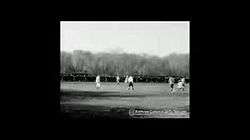Club Atlético Porteño
 | |||
| Full name | Club Atlético Porteño | ||
|---|---|---|---|
| Union | URBA | ||
| Founded | 28 July 1895 | ||
| Location | San Vicente, Buenos Aires, Argentina | ||
| President | Ricardo Destuet | ||
| Coach(es) | Claudio Spataro | ||
| League(s) | Torneo de la URBA Grupo IV | ||
| 2011 | 5th of Zona B [1] | ||
| |||



Club Atlético Porteño is an Argentine rugby union and field hockey club sited in San Vicente, Buenos Aires. The club was founded on July 28, 1895 by Irish immigrants as a football team, which participated in tournaments organized by the Argentine Football Association until 1931 when the sport became professional in Argentina.
The rugby team plays in the Torneo de la URBA Grupo IV, the fourth division of the Unión de Rugby de Buenos Aires league system.[2]
History
The beginning
In 1895 Cavanagh, Geogeham, Kenny and O’Farrel were just a group of boys who wanted to form a football team, but they had no money. On July 28, 1895, they met in the Hipodromo Argentino de Palermo and founded the "Club Atlético Capital" designing Tomas Hagan as president. A few months later, those immigrants bet the money they had saved to a horse called Porteño, which finally won the race paying a hugh amount of money.
With the money won in the race, the boys bought the equipment necessary to play football: balls, jerseys, shorts, socks and shoes and they renamed the club as a tribute to that horse, so "Club Atlético Porteño" was the name chosen.[3]
The football years (1907-31)
The football team played in Primera División during the amateur era, making its debut in 1907[4] and staying in the top division until 1928 when Porteño was relegated to the second division.[5] Its stadium was the first (in the city of Buenos Aires) to have its stands built in concrete. It was located in Palermo neighborhood, on Valentín Alsina Avenue. In 1931 Porteño desaffiliated from the Football Association, due to the club refused to participate in a professional league, being the team subsequently disbanded.
Porteño's football team won a total of 2 championships between 1912 and 1914 [6] and two Copa de Competencia Jockey Club in 1915 [7] and 1918.[3][8]
The raise of rugby
Although the football team was disbanded, Porteño kept other sports active, such as rugby union, which is currently practised at the club facilities located in San Vicente. The reason why Porteño went off football was that the club wanted to keep as amateur, and rugby union is not a professional sport in Argentina.
Porteño affiliated to Unión de Rugby del Río de la Plata in 1932. The team debuted that season in the third division, finishing 6th. In 1935 Porteño promoted to the second division and in 1939 the team won the first division championship organized by the Federación Católica Argentina de Rugby.
In 1944 the Government of the City of Buenos Aires notified Porteño it had to leave its lands in Palermo, which were finally expropriated in 1945.
In 1951 Porteño won the long-awaited promotion to Primera División, but the team remained there just one season so the following year was relegated after losing its match at the hands of Estudiantes de Paraná.
After playing in different fields, the club finally could acquire a land located in Magallanes and Pardo streets of San Vicente in 1971. Porteño still has its facilities there. The same year the club formed its first women's field hockey team, which has been developing as years went by.
Colors
While the football team colors were blue and white in vertical stripes, it is said that rugby jersey adopted its colors in the 1930s, when a group of players of Sportive Francaise joined Porteño to play for the club. Club Porteño members, in recognition of this gesture, designed the shirt combining the light blue color from the flag of Argentina, and the french blue from France's.
Football 1907-31 |
Rugby 1931-today |
Honours
Football
- Primera División (2): 1912 FAF 1, 1914 FAF
- Copa de Competencia Jockey Club (2): 1915, 1918
- Copa Bullrich (1): 1906
- Notes:
- 1 The "Federación Argentina de Football" (FAF) was a rival association that organized its own championships from 1912 to 1914.
References
- ↑ Posiciones finales del Grupo IV en 2011, Rugbytime.com
- ↑ Grupos para los Torneos de la URBA 2012, Rugbytime website, 2011-12-05
- 1 2 Historia del Fútbol Amateur en la Argentina, Jorge Iwanczuk, Buenos Aires, 1992
- ↑ Argentina 1907 at RSSSF
- ↑ Argentina 1928 at RSSSF
- ↑ Argentina amateur football final tables 1911-20
- ↑ Copa de Competencia 1915 at RSSSF.com
- ↑ Copa de Competencia 1918 at RSSSF.com